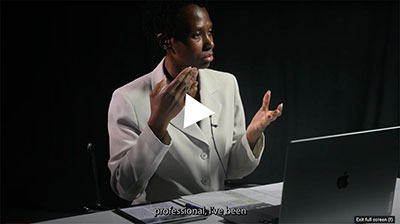You are here:
Deaf Students Protest New School Head

Date: Apr 27, 1994
Caption: Students at the Lexington School for the Deaf in Queens organized to demand a Deaf principal for their school.

Gallaudet University in Washington, DC was one of the earliest US schools for the Deaf and the world’s only university for the Deaf and hard of hearing. Thomas Gallaudet was an educator who founded the American School for the Deaf after he took an interest in trying to teach a neighbor’s deaf daughter. His son, Edward, went on to found Gallaudet University in 1864.
Despite the movement against teaching sign language that started in the 1860s, Edward resisted the sentiments of the time and Gallaudet continued to teach in sign language. Many of the early leaders of the university were hearing men who had a background in deaf education or a connection to a deaf family member. In the 1980s, students started questioning why the president could not be a Deaf person. After several years of student organizing, Gallaudet’s Board of Trustees promoted a hearing woman over two Deaf men. This set off protests for a “Deaf President Now” in 1988, leading the director of the board to resign. The university then hired its first Deaf president in 124 years.1
In 1994, students at the Lexington School for the Deaf in Jackson Heights, Queens, took inspiration from Gallaudet’s example, pushing for a “Deaf CEO Now,” after a hearing banking executive was hired as the school’s new leader. The school had never had a Deaf leader. Parents, educators, and students also had demands for better representation on the board, which had only seven or eight Deaf members out of 45.2 After two months of protests, the head of the school stepped down, clearing the way for a Deaf CEO.3
Deaf students in New York continued to push for change. They wanted to be able to learn sign language as part of their formal education. New understandings about Deafness and language development through research also supported their case. After decades of advocacy by parents and educators, P.S. 47, New York City’s public school for the deaf, officially changed their policy to teach primarily in sign language. A New York Times article about the policy change noted that the school would focus on “bilingual teaching instead of treating pupils as disabled.”4
-
Gallaudet University, “Events Leading up to DPN - The Deaf President Now (DPN) Protest,” accessed July 29, 2023, https://gallaudet.edu/museum/history/the-deaf-president-now-dpn-protest/events-leading-up-to-dpn/. ↩︎
-
David Firestone, “Deaf Students Protest New School Head,” The New York Times, April 27, 1994, https://www.nytimes.com/1994/04/27/nyregion/deaf-students-protest-new-school-head.html. ↩︎
-
David Firestone, “Chief Executive To Step Down At Deaf Center,” The New York Times, June 22, 1994, https://www.nytimes.com/1994/06/22/nyregion/chief-executive-to-step-down-at-deaf-center.html. ↩︎
-
Felicia R. Lee, “New York to Teach Deaf in Sign Language, Then English,” The New York Times, March 5, 1998, https://www.nytimes.com/1998/03/05/nyregion/new-york-to-teach-deaf-in-sign-language-then-english.html. ↩︎
Watch a close reading of this document

Categories: student activism, Queens, K-12 organizing
Tags: Deaf culture, self-determination, American Sign Language
This item is part of "The Right to Communicate" in "Seeking Equity for Disabled Students"
Item Details
Date: Apr 27, 1994
Creator: David Firestone
Source: The New York Times
Copyright: Under copyright. Used with permission.
How to cite: “Deaf Students Protest New School Head,” David Firestone, in New York City Civil Rights History Project, Accessed: [Month Day, Year], https://nyccivilrightshistory.org/gallery/lexington-school-for-deaf.
Questions to Consider
- Why did Deaf people push for Deaf leaders at their schools?
- How might having a Deaf CEO help students and teachers?
References
How to Print this Page
- Press Ctrl + P or Cmd + P to open the print dialogue window.
- Under settings, choose "display headers and footers" if you want to print page numbers and the web address.
- Embedded PDF files will not print as part of the page. For best printing results, download the PDF and print from Adobe Reader or Preview.
